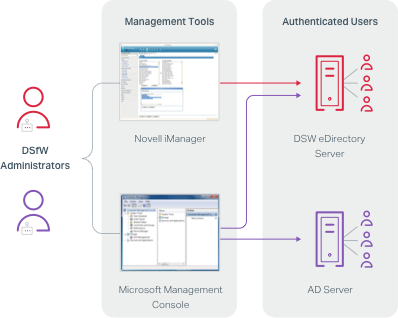Domain Services for Windows 能簡化使用者和群組管理作業並降低混合式環境的基礎架構複雜性。此項創新技術可讓 Microsoft Windows 使用者使用原生 Windows 和 Active Directory 協定存取 OES 服務。
透過讓 Open Enterprise Server 上執行的 Micro Focus eDirectory™ 伺服器如同 Active Directory 伺服器般運作,此項技術可讓同時具有兩種目錄服務部署的企業增進兩個平台間的共存性。使用者無需在桌面安裝 OES Windows Client™,亦能一邊在純粹的 Windows 桌面環境中工作,一邊利用部分 Open Enterprise Server 後端服務和技術。

Domain Services for Windows 讓使用者無需進行多次登入或安裝 OES Windows Client for Windows,即可從 Windows 工作站登入及驗證進入 Micro Focus eDirectory 和 Active Directory,為使用者提供更簡便的操作體驗。
Domain Services for Windows 並藉由在 Micro Focus eDirectory 和 Active Directory 之間建立跨樹系信任關係,免除身分識別儲存區的同步與複製作業。這表示您可以降低基礎架構複雜性、簡化使用者管理作業及縮減對目錄伺服器硬體的投資成本。
跨樹系信任關係還可讓管理員使用 Micro Focus iManager 或 Microsoft 管理主控台對所有的使用者執行基本的使用者管理作業,從而降低訓練和支援成本。
此外,由於 Domain Services for Windows 網域在外觀和運作方式上與 Active Directory 網域幾乎一樣,因此能夠進行許多 AD 類應用程式的驗證作業,不用再為了要新增需要 AD 驗證的應用程式而另外部署 AD 伺服器。
在多數情況下,Domain Services for Windows 無需建立 Active Directory 基礎架構即可直接執行特定 Active Directory 類應用程式。
對許多 Active Directory 類應用程式而言,Domain Services for Windows 網域在外觀和運作方式上與 Active Directory 網域幾乎一樣。因此,當使用者驗證進入 Domain Services for Windows 後,許多這類應用程式都會將 Domain Services for Windows 認證視為有效,並自動讓他們登入應用程式,而不會要求他們輸入使用者名稱和密碼。這一切不需要 Active Directory 網域也能達成。
雖然我們已在多種 Active Directory 類應用程式 (包括 Citrix Presentation Server) 上驗證過其可用性,但該方法可能無法適用於所有這類應用程式上。即便 Domain Services for Windows 使用的驗證機制與 Active Directory 幾乎一樣,但諸如 Microsoft Exchange 這類使用進階 API 並需要特定延伸綱要的應用程式,目前仍可能無法利用此一功能。
除了可讓 Micro Focus eDirectory 使用者驗證進入特定 Active Directory 類應用程式外,Domain Services for Windows 提供的跨樹系信任關係亦可讓 Active Directory 使用者驗證進入 Domain Services for Windows 網域內的 Active Directory 類應用程式。
Domain Services for Windows 能讓組織在 Micro Focus eDirectory 和 Active Directory 的身分識別儲存區間建立跨樹系信任關係,並以一個使用者帳戶來代表每位使用者,不論該帳戶位於何處。
有了這層跨樹系信任關係,Domain Services for Windows 樹系中的 Micro Focus eDirectory 使用者便能使用其原生的 Windows 用戶端驗證提出和列印服務,並同時利用此解決方案的無縫交叉驗證功能,讓使用者能夠使用他們的 Micro Focus eDirectory 使用者名稱和密碼驗證進入 Active Directory 服務,包括檔案系統、印表機和一些 AD 類應用程式。
Domain Services for Windows 不是一種目錄同步解決方案。它是一種利用在組織的 Active Directory 和 Micro Focus eDirectory 間建立跨樹系信任關係,讓使用者能夠以單一使用者帳戶 (不論該帳戶位於何處) 驗證進入各種服務的解決方案。
事實上,這種跨樹系信任關係可在同時具有 Micro Focus eDirectory 和 Active Directory 基礎架構的組織中,減少執行同步作業和重複身份識別作業的次數,因為使用者的權限和屬性現在只需要在一個 (而非兩個) 目錄儲存庫中進行維護便可。
Domain Services for Windows 是專為想要為使用者 (不論這些使用者需要存取 Linux 伺服器或 Windows 伺服器) 提供完整而一致的 Active Directory 環境的組織而設計的解決方案。這能讓 Open Enterprise Server 看起來像在 Active Directory 網域控制器中,讓使用者使用其使用者主體名稱和 Micro Focus eDirectory 密碼,以原生 Windows 用戶端登入並驗證進入 Active Directory。它亦能讓 Micro Focus eDirectory 使用者利用常見的 Windows 桌面作業系統,透過 Samba 共享功能或使用 CIFS 共享之 Windows 伺服器上的 NTFS 檔案,以及受信任的 Active Directory 樹系中的共享功能,存取 Linux 伺服器上 NSS 磁碟區中的檔案服務。
Domain Services for Windows 支援 Windows 環境中常用的驗證協定,包括 Kerberos。
CIFS 可在不需 OES Windows 用戶端的狀況下,讓使用者直接從 Windows 工作站取得基本工作群組驗證功能,並可存取 Linux 上的 NSS 檔案,同時免去 Active Directory 式呈現的負擔,適合有如此需求的組織使用。這些組織並不需要 Kerberos 驗證、Microsoft 管理主控台或 Windows 群組規則支援。他們的使用者只是想要能夠從原生用戶端連線及存取網路磁碟而已。
CIFS 通常適用於以 Open Enterprise Server 作為主要環境,而且單純只想讓使用者不依靠 OES Windows 用戶端就能驗證進入網路資源的組織。其他適用對象還包括一直在 NetWare 上使用 CIFS,但即將移轉至 Linux 的組織。他們單純只想要繼續使用 CIFS 協定提供的原生 Windows 驗證。